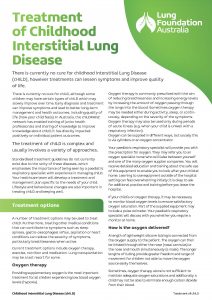chILD refers to a group of rare lung disorders that impair oxygen absorption in the lungs, leading to breathing difficulties and reduced oxygen supply to other organs. Early diagnosis is crucial, as symptoms can vary in severity and worsen over time. It’s important to know each child experiences chILD differently. Some cases are mild with symptoms that slowly improve over time without treatment. In other cases, symptoms can remain severe and may lead to other complications and more complex treatments.
The treatment of Childhood Interstitial Lung Disease (chILD) focuses on alleviating symptoms and improving the quality of life, though there is currently no cure. This fact sheet is designed for parents, caregivers, and healthcare professionals to understand the complexities of treating chILD. It outlines various treatment options tailored to the specific needs of each child, emphasizing the importance of early diagnosis and individualized care plans developed by paediatric respiratory specialists.
Key treatments for chILD include oxygen therapy, which helps children with low oxygen levels by increasing oxygen intake, and non-invasive ventilation for those with severe breathing difficulties. In some cases, medications such as anti-inflammatory drugs and immune-modifying therapies are used to manage inflammation and improve lung function. Nutrition is also a crucial component of treatment, as poor growth and weight gain are common in children with chILD. The fact sheet stresses the need for dietary assessments and the use of feeding tubes or supplements when necessary.
Exercise is encouraged for most children with chILD to improve overall fitness and manage breathlessness. Pulmonary rehabilitation, though limited in availability for children, is another beneficial intervention. In severe cases, when other treatments fail, lung transplantation may be considered as a last resort. The fact sheet also discusses the roles of various healthcare professionals involved in the care of children with chILD, including specialists in respiratory medicine, cardiology, nutrition, and mental health.
This resource provides essential information on managing the condition, ensuring families are equipped with the knowledge to work effectively with healthcare teams to improve outcomes and quality of life for children living with chILD.
Was this page helpful?
Good job! Please give your positive feedback
How could we improve this post? Please Help us.
